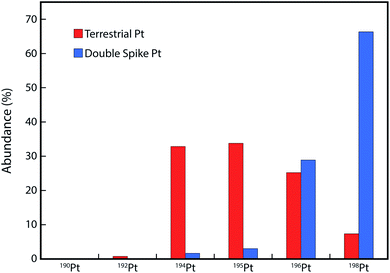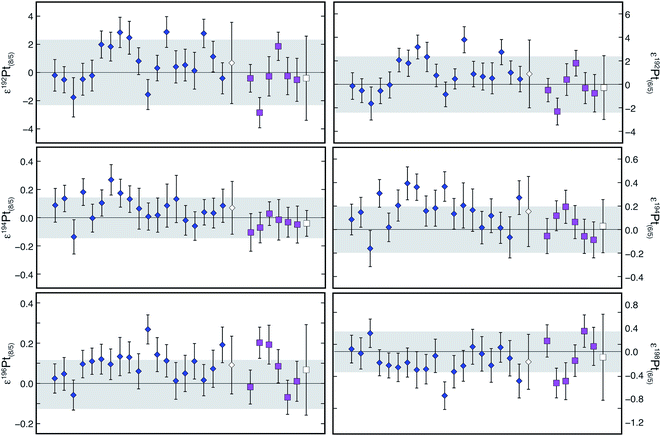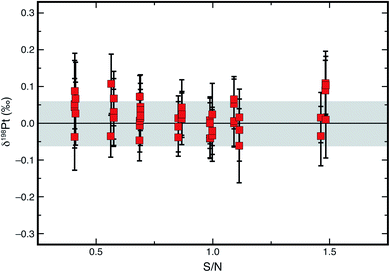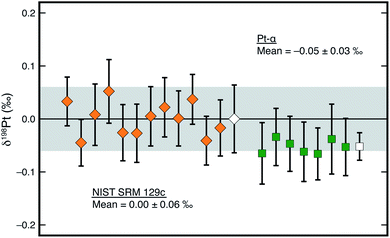 Open Access Article
Open Access ArticleCreative Commons Attribution 3.0 Unported Licence
New methods for determination of the mass-independent and mass-dependent platinum isotope compositions of iron meteorites by MC-ICP-MS†
Graeme M.
Poole
 *abc,
Roland
Stumpf
a and
Mark
Rehkämper
*abc,
Roland
Stumpf
a and
Mark
Rehkämper
 a
a
aDepartment of Earth Science and Engineering, Imperial College London, London SW7 2AZ, UK. E-mail: graeme.poole@nhm.ac.uk
bSchool of Earth Sciences, University of Bristol, Bristol BS8 1RJ, UK
cImaging and Analysis Centre, Natural History Museum, London SW7 5BD, UK
First published on 18th March 2022
Abstract
Improved methods are presented for the separation of platinum from iron meteorites and subsequent analyses of both mass-independent and mass-dependent Pt isotope compositions of iron meteorites by multiple collector ICP-MS. The procedures are optimised for sample throughput and feature improvements in yield and the reduction of constituents that produce spectral interferences and matrix effects. The performance of the methods is demonstrated by replicate analyses of terrestrial reference materials and eight iron meteorites from the IC and IVB groups. The pilot iron meteorite analyses confirm previous work, which demonstrates that the Pt isotope compositions of iron meteorites are particularly sensitive to alteration by neutron capture reactions induced by exposure to galactic cosmic rays (GCR). It is shown that the mass-independent Pt isotope data obtained with the new methods are suitable for accurate correction of correlated cosmogenic isotope effects for other isotope systems in the same sample aliquots. The methods for the measurement of mass-dependent Pt isotope compositions (δ198Pt) employ a robust double spike approach. The accurate determination of δ198Pt values for iron meteorites requires, however, that possible cosmogenic isotope effects from GCR exposure are monitored and appropriately corrected on a sample aliquot specific basis. A robust approach for such corrections using the mass-independent Pt isotope data collected with the new methods is shown to provide accurate results for iron meteorites with variable compositions and GCR exposure histories. Initial results obtained for eight IC and IVB iron meteorites reveal both within- and between-group variations in δ198Pt values, which indicate that such analyses may provide novel constraints for studies of planetary processes.
Introduction
In recent years, platinum isotopes have gained increasing importance in cosmochemistry, with several studies focusing on Pt isotope variations of cosmogenic origin in iron meteorites.1,2 Galactic cosmic rays (GCR) are known to cause effects in the isotopic compositions of meteorites via spallation and neutron capture reactions, with Pt isotopes particularly susceptible to the latter.1,3 With the better precision afforded by improvements in sample preparation and mass spectrometry methods, neutron capture reactions have been found to affect many isotope systems in iron meteorites, such as the short-lived Hf–W and Pd–Ag decay systems, as well as the isotope compositions of Mo, Ru and Os.4–9 Such GCR effects can overprint other isotope effects of interest, such as radiogenic or nucleosynthetic isotope anomalies, and therefore must be corrected in order to obtain accurate “pre-exposure” data for the isotope system of interest. To do so, an isotope system that solely records GCR effects can be used as an in situ neutron dosimeter. In combination with the lack of resolvable nucleosynthetic Pt isotope anomalies,2,10 the susceptibility of Pt isotopes to GCR effects render them a well-suited, and increasingly applied, system for use as in situ neutron dosimeters for correcting the isotopic data of other elements for GCR exposure.5–7,11The susceptibility of the different Pt isotopes to GCR effects, and any variations in the isotope ratios these create, are not constrained by the relative masses of the isotopes, and hence the isotope variations are referred to as mass-independent. In contrast, variations in mass-dependent isotope compositions arise from physicochemical processes that fractionate isotope abundances, and hence ratios, based on differences in atomic mass. While there have been numerous investigations into mass-independent Pt isotope effects in iron meteorites, mass-dependent Pt isotope variations have yet to be fully explored, with only limited previous investigations.10 Mass-dependent isotope fractionations for other elements have previously been studied to investigate processes in planetary bodies. For instance, planetary differentiation and core formation have been explored using Cr, Mo, Si and other isotope systems.12–14 Platinum is a highly siderophile element with relatively high concentrations of up to about 50 μg g−1 in iron meteorites. Therefore, Pt isotopes offer a potentially useful tool to improve understanding of the processes and conditions relevant for the formation of iron meteorites and their parent bodies.
Here, we present new and improved analytical methods for studies of Pt isotopes in iron meteorites. To this end, we developed a more efficient separation procedure for Pt that can be used for both mass-independent and mass-dependent isotope studies. This method, combined with the isotopic analyses by multiple collector inductively coupled plasma mass spectrometry (MC-ICP-MS), is optimised for sample throughput to enable in situ neutron dosimetry for use in correcting data for other isotope systems disturbed by (mass-independent) GCR effects in the same samples. It can also be applied to help build a database of dosimetry information and to quantify the range of offsets from the terrestrial Pt isotope composition that GCR effects generate in different iron meteorite groups. For mass-dependent Pt isotope studies, we have developed an optimised analytical procedure that applies a Pt double-spike and uses the in situ dosimetry to remove the mass-independent (GCR) effects from the data for each specific sample and obtain accurate mass-dependent Pt isotope fractionations. As such, the methods are suitable for future high-precision Pt isotope studies of iron meteorites that investigate planetary processes, such as accretion, core formation and core crystallisation.
Methods
Reagents and materials
All sample preparation was performed in ISO class 4 laminar flow hoods in an ISO class 6 clean room at the MAGIC Laboratories at Imperial College London. To avoid any cross-contamination with the double spike, laboratory work for mass-independent and mass-dependent isotope analyses took place in separate flow hoods, using separate reagents and laboratory equipment. Concentrated HNO3 (15 M), 6 M HCl and concentrated HCl (11 M) were purified in-house by sub-boiling distillation in quartz and PFA stills, respectively. Trace element grade Optima HBr (8 M) and Optima HClO4 (12 M) were purchased from Fischer Scientific. All necessary dilutions were made using H2O purified to >18 MΩ cm quality by a Millipore Academic system. Savillex PFA vials were used for sample handling, and were cleaned sequentially in 8 M HNO3, 6 M HCl and dilute distilled acids (HNO3 and HCl). Prior to use, the vials received a final cleaning by refluxing with a solution of distilled 6 M HCl.Alfa Aesar 99% n-heptane was pre-cleaned using liquid–liquid extraction as outlined previously.15 Herein, approximately 40 ml of heptane and 20 ml 6 M HCl were shaken together for 30 seconds in a 90 ml Savillex beaker and then left to stand for 3 minutes to allow for phase separation. Following this, the beaker was shaken again and allowed to stand for a further three minutes. The heptane was then carefully pipetted into a clean beaker and the entire cleaning process was repeated twice more.
Samples
This investigation used aliquots of iron meteorite solutions from a companion study (for continuity, the same sample numbers are used).16 Specifically, eight iron meteorites from the IC and IVB groups, obtained from the Natural History Museum, London, were analysed. Iron meteorites are classified into groups based on the chemical compositions, whereby all meteorites from an individual group are derived from a single parent body. The IC and IVB groups were selected here due to (i) the ready availability of meteorites from these groups and (ii) the range of chemical compositions displayed by the meteorites within each group.The robustness and reproducibility of the Pt separation procedure and the MC-ICP-MS Pt isotope measurements were routinely evaluated by repeated analyses of terrestrial standard reference materials. The NIST SRM (standard reference material) 129c High-Sulphur Steel was chosen for this purpose due to a major element composition that is somewhat similar to iron meteorites, with a high S content of about 2%. For analysis, the SRM was doped with a solution of SRM IRMM-010 Pt prior to digestion, to approximate the Pt concentrations of the iron meteorites, and then processed through the full digestion and chemical separation procedure and analysed together with the samples. In addition, a second in-house Pt standard solution, denoted Pt-α, was analysed versus IRMM-010 Pt to monitor data quality.
Sample preparation
The iron meteorites were prepared for analysis as described in the companion study.16 Briefly, the samples were sequentially leached, at room temperature, in 0.5 M HBr, 6 M HCl and modified aqua regia (prepared from 6 M HCl and 15 M HNO3, 3![[thin space (1/6-em)]](https://www.rsc.org/images/entities/char_2009.gif) :
:![[thin space (1/6-em)]](https://www.rsc.org/images/entities/char_2009.gif) 1), to remove the outer surface and any terrestrial contamination. The leached samples were then submersed in distilled ethanol, dried and weighed. Following this, the samples, and NIST SRM 129c, were fully digested in modified aqua regia on a hotplate at 100–140 °C.
1), to remove the outer surface and any terrestrial contamination. The leached samples were then submersed in distilled ethanol, dried and weighed. Following this, the samples, and NIST SRM 129c, were fully digested in modified aqua regia on a hotplate at 100–140 °C.
Platinum double spike preparation and calibration
To accurately determine natural mass-dependent isotope variations of samples via mass spectrometry, the instrumental mass-dependent isotope fractionation (IMF) must be corrected for. The double-spike technique, whereby two artificially enriched isotopes are mixed with the sample and used as a tracer for the IMF, provides the most accurate approach for obtaining such data with the precision required to resolve mass-dependent isotope variations in planetary samples (typical variations of 0.1–1 parts per 1000).In this study, the double spike technique was used for the acquisition of mass-dependent Pt isotope data. For preparation of the Pt double spike, enriched single isotopes of 198Pt and 196Pt were obtained from Isoflex USA in the form of Pt wire and digested in aqua regia. Based on double spike toolbox calculations,17 the Pt double spike was gravimetrically prepared by mixing the 198Pt and 196Pt single spike solutions to produce a mixture with a ratio of 198Pt/196Pt ≈ 2.64.
The 198Pt–196Pt double spike composition was calibrated in two steps. Initial isotopic analyses applied external normalisation to admixed Ir for correction of the instrumental mass bias. An Ir-doped solution of IRMM-010 Pt was first analysed by MC-ICP-MS. The Pt isotope ratios of these runs were corrected for instrumental mass bias by both internal and external normalisation to 196Pt/194Pt and 193Ir/191Ir, respectively. The reference ratio (193Ir/191Ir)Ref employed in this procedure was empirically optimised to provide the best possible agreement between the isotope ratios normalised to Pt and Ir. This was followed by concentration-matched runs of the Ir-doped Pt double spike solution. In these analyses, the Pt isotope ratios were corrected for instrumental mass bias by external normalisation relative to the empirically optimised (193Ir/191Ir)Ref ratio from the previous IRMM-010 Pt runs. These measurements provided a provisional isotope composition for the 198Pt–196Pt double spike. In a second step, multiple mixtures of the Pt double spike and IRMM-010 Pt were prepared and analysed, whereby the mixtures had ratios of spike-derived to natural Pt (S/N ratios) of about 0.8 to 1.2.18 A least squares approach was then applied using the Pt isotope data acquired for the mixtures, to define a marginally altered but optimised Pt double spike composition (Fig. 1).
Ion-exchange chromatography
Separation of Pt from the samples prior to both mass-independent and mass-dependent Pt isotope analyses was achieved with an anion-exchange chromatography procedure (Table 1). The single-column protocol, adapted from ref. 19 and 20, is optimised for efficient sample throughput. For mass-independent Pt isotope analyses, 30–100 mg of meteorite (∼1000 ng Pt) were loaded onto the columns for each sample. For mass-dependent isotope analyses, 20–60 mg of meteorite (∼600 ng natural Pt) were processed for each sample and prior to the separation chemistry, the sample solutions were mixed and equilibrated with the Pt double spike by refluxing on a hotplate for at least 24 hours.| Quartz column, 3 ml resin reservoir, 50 ml acid reservoir | ||
|---|---|---|
| Resin: Bio-Rad AG1-X8, 200–400 mesh, chloride form (1 ml) | ||
| Step | Resin volumes | Acid |
| a Step followed by rinse with 1 ml H2O to prevent aqua regia forming in resin during next step. | ||
| Cleaning | 1.5 | 8 M HNO3a |
| 1.5 | 11 M HCl | |
| 1 | 1 M HCl | |
| Pre-condition resin | 4 | 1 M HCl |
| Load sample | 2–4 | 1 M HCl |
| Elute matrix (inc. Fe, Ni) | 40 | 0.5 M HCl |
| Elute Ir, Os, Re, Pd | 50 | 11 M HCla |
| Elute and collect Pt | 14 | 13.5 M HNO3 |
Following the full separation and clean-up chemistry, the purified Pt fractions typically had Os/Pt and Hg/Pt ratios of less than 1 × 10−5. The procedural blank of the full sample preparation procedure was routinely monitored and ranged from 10–50 pg Pt. Considering that samples with ∼1000 ng Pt were typically processed, the blank contribution to the total Pt analysed was negligible at <0.05‰. Total Pt yields were consistently 80–95%. This represents an improvement compared to previous procedures for Pt separation from iron meteorites, with reported yields of 50–70% (ref. 21) and ∼70% Pt (ref. 22).
Elution of Pt with nearly concentrated (13.5 M) HNO3 can cause decomposition of the ion-exchange resin and subsequent release of organic compounds. Consequently, the resin cannot be re-used and fresh resin was taken for every procedure. As all Pt is eluted from the columns in this final step of the procedure, any resin decomposition will have no impact on Pt yields.
However, the released organic compounds can have a detrimental impact on the quality of isotope analyses by MC-ICP-MS (e.g., ref. 23). To mitigate such effects, a published method,15 which employs liquid–liquid extraction with n-heptane, was employed to remove organic compounds from the eluate prior to the MC-ICP-MS analyses. The extraction procedure encompassed the following steps: (i) 10 ml pre-cleaned n-heptane were added to the eluate and shaken in a Savillex beaker for 30 seconds and then rested for 3 minutes. (ii) The shaking–resting was repeated a further two times. (iii) The organic phase was carefully removed with a pipette. (iv) The entire n-heptane procedure (steps i to iii) was then repeated. (v) After the organic phase was removed for the second time, any residual heptane was allowed to evaporate at ambient temperature in a laminar flow hood for 30–60 minutes.
Finally, the Pt fractions were dried down with a mixture of 15 M HNO3 and 12 M HClO4 to volatilise any remaining Os (as OsO4), before being dissolved in 0.5 M HCl ready for MC-ICP-MS analysis.
Mass spectrometry
All isotope measurements were performed at the Imperial College London MAGIC Laboratories with a Nu Instruments Nu Plasma HR MC-ICP-MS. Sample introduction utilised a Cetac autosampler and a Nu Instruments DSN-100 desolvation system equipped with Micromist crossflow nebulisers with uptake rates of ∼140 μl min−1. Typical sensitivity for Pt, measured by Faraday cups with 1011 Ω resistors, was 180–210 V (μg−1 ml−1), resulting in 196Pt ion beams of 6–7 V for solutions with ∼100 ng ml−1 natural Pt. All analyses utilised 3 blocks with 20 integrations of 5 seconds each. Each block was preceded by a 30 second on-peak baseline measurement while the ion beam was deflected by the electrostatic analyser.| Faraday cup | L5 | L4 | L3 | L2 | L1 | Ax | H1 | H2 | H3 | H4 | H5 | H6 |
|---|---|---|---|---|---|---|---|---|---|---|---|---|
| Mass-independent | 188 | 191 | 192 | 194 | 195 | 196 | 198 | 200 | ||||
| Mass-dependent | 193 | 194 | 195 | 196 | 198 | 200 |
To obtain mass-independent isotope compositions, all mass-dependent isotope effects of natural and instrumental origin must be corrected. This is best achieved using internal normalisation, which fixes a particular Pt isotope ratio to the terrestrial value. Two separate internal normalisation schemes were employed here, with normalisation to both 198Pt/195Pt = 0.216277 and 196Pt/195Pt = 0.748446, using the exponential law.25–27 Since these ratios have isobaric interferences (Hg on 196Pt and 198Pt), an iterative procedure was used to subtract these effects from the normalisation ratios.
Data for samples are reported in εiPt notation (eqn (1)), calculated relative to the mean of several bracketing runs of an IRMM-010 Pt solution, made up to closely match (to within 5%) the Pt concentration of the samples (∼100 ng g−1):
 | (1) |
Since the double spike is calibrated relative to the IRMM-010 Pt reference material, any variations in mass-dependent Pt isotope compositions calculated using the double-spike are determined relative to the composition of IRMM-010 Pt. Following convention, such variations are reported in δ-notation, based on variations in the 198Pt/194Pt ratio:
 | (2) |
The δ198Pt values are thereby calculated relative to the mean results obtained for several bracketing runs of the IRMM-010 Pt reference material to which Pt double spike had been admixed. The double spiked IRMM-010 Pt solutions were made up to closely match both the total Pt concentrations (of ∼100 ng g−1) and the S/N ratios of the samples.
Resolving mass-dependent and mass-independent Pt isotope effects
The double spike data reduction determines the δ198Pt value of a sample, based on the assumption that the isotopic difference between the sample and a standard reference material that represents δ198Pt = 0 (here represented by IRMM-010 Pt) is solely the result of mass-dependent isotope fractionation. However, when samples also host mass-independent isotope effects, biased results will be obtained for the mass-dependent isotope fractionation between sample and standard and hence the δ198Pt values of the sample, unless corrections are applied to resolve the mass-dependent and mass-independent isotope effects (e.g., ref. 18).Platinum isotopes in iron meteorites are known to exhibit mass-independent anomalies from exposure to GCR.1,3 Hence, analyses of such meteorites to determine mass-dependent Pt isotope fractionations (δ198Pt) using the double spike method must accurately account for mass-independent isotope effects. One approach to achieve this would be to model and remove the mass-independent contribution to the δ198Pt value determined by the double spike measurements. It was previously shown that such an approach can accurately remove the effects of nucleosynthetic isotope anomalies from analyses to determine the mass-dependent Mo isotope compositions of iron meteorites.14,31 However, this method can only provide accurate results if the magnitude and isotopic patterns of the mass-independent isotope effects are known with a high degree of confidence. For Mo, the nucleosynthetic isotope anomalies are well understood and so the approach is valid. However, whilst models of GCR effects on Pt isotopes in iron meteorites yield useful first order estimates,1,3 significant discrepancies remain between measured and modelled data. These discrepancies have been attributed to limitations and uncertainties in the models, namely with respect to shielding depths, exposure ages and differences in chemical compositions.1,2 Therefore, this approach is much less appropriate for the Pt isotope system.
An alternative approach to remove the effects of mass-independent isotope anomalies on the determination of mass-dependent isotope fractionations, involves use of the independently determined mass-independent isotope effects of each sample in the double spike data reduction. This approach was previously applied to determine mass-dependent Mo, Ru and Sr isotope data for meteorites14,32,33 and it is used here for Pt. For Pt, the approach entails that the internally normalised mass-independent Pt isotope data for the unspiked sample (determined relative to IRMM-010 Pt) are applied to define the δ198Pt = 0 reference composition, rather than the composition of IRMM-010 Pt. The δ198Pt value that is provided by the procedure then characterises only the mass-dependent isotope effects. The uncertainties associated with the mass-independent Pt isotope measurements were thereby propagated through all data reduction and correction procedures, which are further described below.
Results and discussion
Determination of mass-independent Pt isotope compositions
| ε 192Pt(8/5)a | ε 194Pt(8/5)a | ε 196Pt(8/5)a | ε 192Pt(6/5)b | ε 194Pt(6/5)b | ε 198Pt(6/5)b | |
|---|---|---|---|---|---|---|
| a Normalised to 198Pt/195Pt = 0.216277 using the exponential law, εiPt = [(iPt/195Pt)smp/(iPt/195Pt)std − 1] × 104. b Normalised to 196Pt/195Pt = 0.748446 using the exponential law, εiPt = [(iPt/195Pt)smp/(iPt/195Pt)std − 1] × 104. | ||||||
| Between-run precision (±2sd) | 2.25 | 0.15 | 0.12 | 2.26 | 0.19 | 0.35 |
| Within-run precision (±2se) | 1.13 | 0.12 | 0.08 | 1.17 | 0.15 | 0.25 |
A similar between-run precision to that obtained for the IRMM-010 Pt measurements was determined for replicate analyses of Pt-α solutions relative to IRMM-010 Pt (Table 3). In addition, comparable results were also obtained for multiple measurements of NIST SRM 129c, which was doped with IRMM-010 Pt and processed by digestion and the column chemistry. Furthermore, the analyses of both Pt-doped NIST SRM 129c and the Pt-α solution yielded terrestrial Pt isotope compositions for all normalisation schemes (Fig. 2 and ESI Table S1†).
| Group | Sample | NHM BMa | N | ε 192Pt(8/5)c | ε 194Pt(8/5)c | ε 196Pt(8/5)c | ε 192Pt(6/5)d | ε 194Pt(6/5)d | ε 198Pt(6/5)d |
|---|---|---|---|---|---|---|---|---|---|
| a Natural History Museum, London, BM collection number. b Number of times sample analysed. c Normalised to 198Pt/195Pt = 0.216277 using the exponential law, εiPt = [(iPt/195Pt)smp/(iPt/195Pt)std − 1] × 104. d Normalised to 196Pt/195Pt = 0.748446 using the exponential law, εiPt = [(iPt/195Pt)smp/(iPt/195Pt)std − 1] × 104; uncertainties are 2se = 2σ/√n, where n is the number of sample analyses. | |||||||||
| IC | Arispe 3 | 2005,M11 | 4 | 11.80 ± 1.36 | 0.85 ± 0.13 | 0.55 ± 0.08 | 13.49 ± 1.11 | 1.44 ± 0.11 | −1.64 ± 0.25 |
| Arispe 4 | 2005,M11 | 12 | 12.96 ± 0.45 | 0.97 ± 0.04 | 0.61 ± 0.04 | 15.15 ± 0.69 | 1.56 ± 0.05 | −1.83 ± 0.11 | |
| Bendego 1 | 1938,2656 | 3 | −0.19 ± 0.88 | 0.85 ± 0.14 | 0.61 ± 0.16 | 2.66 ± 0.90 | 1.46 ± 0.05 | −1.83 ± 0.48 | |
| Bendego 2 | 1938,2656 | 4 | 2.45 ± 2.19 | 1.20 ± 0.19 | 0.96 ± 0.02 | 5.28 ± 2.20 | 2.23 ± 0.17 | −2.87 ± 0.07 | |
| Santa Rosa | 1985,M291 | 5 | 0.99 ± 0.53 | 0.00 ± 0.10 | 0.31 ± 0.08 | 1.70 ± 0.34 | 0.24 ± 0.05 | −0.65 ± 0.14 | |
| IVB | Cape of Good Hope | 1985,M246 | 4 | 23.94 ± 1.49 | 1.18 ± 0.08 | 0.56 ± 0.08 | 25.62 ± 1.60 | 1.67 ± 0.08 | −1.67 ± 0.25 |
| Santa Clara | 1983,M27 | 6 | 15.48 ± 0.79 | 1.26 ± 0.19 | 0.71 ± 0.07 | 17.58 ± 0.89 | 1.99 ± 0.22 | −2.12 ± 0.20 | |
| Tlacotepec 1 | 1959,913 | 4 | 55.15 ± 1.12 | 2.11 ± 0.11 | 0.89 ± 0.06 | 57.75 ± 1.48 | 3.05 ± 0.15 | −2.66 ± 0.17 | |
The purified Pt fractions of the iron meteorites typically had Os/Pt and Hg/Pt ratios of less than 1 × 10−5 and these were associated with maximum interference corrections of 350 ppm for ε192Pt and 40 ppm for ε198Pt. Molecular interferences (e.g., from 152Sm40Ar on 192Pt, 182W16O on 198Pt) were also routinely monitored after the isotope analyses but these were sufficiently small to be completely negligible. The isotope 191Ir was monitored as it can produce tailing effects on 192Pt (e.g., ref. 1). During the course of this study, the abundance sensitivity of the Nu Plasma HR MC-ICP-MS, measured on 237U versus238U, was ∼1 ppm. For the samples analysed here, the Ir/Pt ratios of the Pt fractions ranged from 0.002 to 0.1, which implies that tailing effects from 191Ir impacted the ε192Pt values by less than 0.2 ε-units. No corrections for the tailing effects were applied in this study, as the ε192Pt data for iron meteorites typically had significantly larger analytical errors of about ±0.5 to ±2.2 ε-units (Table 4). Notably, our separation procedure produces Pt separates that have lower Ir/Pt ratios and which hence have less tailing effects on 192Pt than other published methods. For instance, the Pt fractions separated from iron meteorites with the separation procedure of ref. 1 had Ir/Pt ratios of between 0.25 and 1.5, which would require tailing corrections for ε192Pt of about 2 to 15 ε-units. Unlike previous methods (e.g., ref. 2), our procedure produced Pt separates that have sufficiently low Ir/Pt ratios, such that a second clean-up column to further reduce Ir levels is not required. This single column procedure thereby significantly reduces the time needed for sample preparation, enabling an improved sample throughput.
During the iron meteorite analyses, attention was also paid to nebuliser uptake rates, as the presence of organic compounds that are released from the ion exchange resin by the 13.5 M HNO3 used for Pt elution could cause fluctuations in flow-rate that may be detrimental to data quality. However, no such problems were encountered, which implies that the n-heptane extraction successfully removed problematic compounds.
Notably, the observed Pt isotope anomalies of the iron meteorites (Table 4), are in good accord with the expected trends and the cosmogenic isotope systematics predicted by quantitative GCR models3 (Fig. 3). Such models, however, provide only a first order prediction of the expected cosmogenic isotope effects and they were found to be inaccurate in some cases, most likely due to uncertainties and variations in exposure ages and chemical compositions.1,2 Moreover, the models are only able to account for the shielding depths of meteorites with pre-exposure atmospheric radii of up to 120 cm. Nevertheless, the good agreement found between our meteorite data and the modelled trends lends credence to the quality of the Pt isotope results.
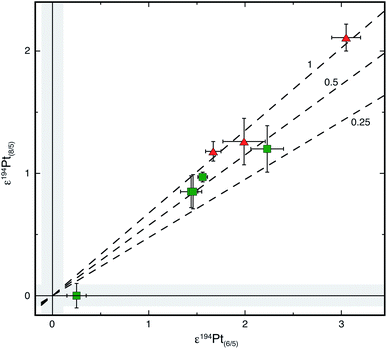 | ||
| Fig. 3 Plot of ε194Pt(8/5)vs. ε194Pt(6/5) for all iron meteorites analysed (green squares = IC irons; red triangles = IVB irons). All data are mean values with uncertainties of 2se = 2sd/√n, where n = number of times sample analysed. Grey shaded area represents 2sd of bracketing IRMM-010 Pt SRM runs. Also shown are the cosmogenic Pt isotope trends predicted by modelling for Ir/Pt ratios of 1, 0.5 and 0.25.3 | ||
Our data are, furthermore, in good agreement with the results of previous iron meteorite analyses1,11,21,22 with similar patterns of excesses for ε192Pt(8/5), ε194Pt(8/5), and ε196Pt(8/5). However, care must be taken with such comparisons, as cm-scale variations in compositions and shielding depths across a meteorite can induce ε-level changes in 192Pt abundances.3,21 For instance, the ε192Pt(8/5) value for our sample of Tlacotepec (55.15 ± 1.12) differs from a previous result of 58.6 ± 2.2 and this difference may reflect a separation in the pre-atmospheric shielding depth of only 3 cm or less.1 Similarly, our analyses of Santa Clara yielded higher ε194Pt(8/5) and ε196Pt(8/5) values compared to those of ref. 1 and 21. However, the ratio of the excesses in ε194Pt(8/5)versus ε196Pt(8/5) are identical, suggesting that our sample of Santa Clara was more exposed to GCR, perhaps because it was situated closer to the meteoroid surface.
The neutron dosimetry afforded by precise mass-independent Pt isotope data of iron meteorites can be used to empirically correct the results obtained for other isotope systems, such as W, Mo, Ru and Pd, for GCR-induced isotope effects.5–7,11 However, the observed variations in cosmogenic Pt isotope effects even for samples of the same meteorite and the known discrepancies between modelled and measured anomalies,2 demonstrate that such corrections must be sample-specific to be accurate. This correction approach is illustrated in Fig. 4. In this figure, the Mo isotope data of the companion study16 are plotted versus the Pt isotope compositions of this study, whereby both analyses were obtained for the same IC iron meteorite sample aliquots; also shown are additional results from the literature.11,22,34 The observed variations in εiMo and εiPt correlate as expected for cosmogenic isotope effects11,22 and a pre-exposure Mo isotope composition for the IC iron meteorite group can be obtained from the intercept at ε196Pt(8/5) = 0. In this case, a pre-exposure ε95Mo of 0.40 ± 0.04 is obtained, in excellent accord with a previous result of 0.40 ± 0.03.11
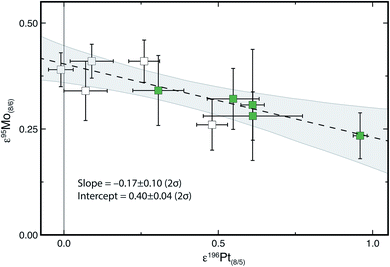 | ||
| Fig. 4 ε 95Mo vs. ε196Pt(8/5) for IC iron meteorites. Solid symbols = Pt data from this study and Mo data, normalised to 98Mo/96Mo, from companion study.16 Open symbols = literature data.11,22,34 A pre-exposure ε95Mo for the IC group is obtained from the intercept at ε196Pt(8/5) = 0. | ||
These results demonstrate that our chemical and mass spectrometric techniques for the determination of mass-independent Pt isotope compositions can provide highly precise sample aliquot specific neutron dosimetry for iron meteorites, whilst utilising a less time-consuming and more effective sample preparation procedure in comparison to published methods.1,2,19,20
Determination of mass-dependent Pt isotope fractionation
Based on these results, samples were spiked to obtain S/N ≈ 0.84. This helps to ensure that there is no detrimental impact on data quality even if the actual spiking was slightly off because the sample Pt concentration was not characterised well, as long as the sample solution features an S/N ratio of between 0.7 and 1.0. The typical between-run reproducibility of bracketing runs of spiked IRMM-010 Pt solutions with ∼100 ng ml−1 total Pt and S/N ≈ 0.84 was ±0.06‰ (2sd) for δ198Pt, with a typical within-run δ198Pt precision of ±0.05‰ (2se).
The robustness and reproducibility of the Pt separation procedure and MC-ICP-MS measurements were routinely evaluated by repeated analyses of terrestrial reference materials. To this end, NIST SRM 129c (High-Sulphur Steel) was mixed and equilibrated with the Pt double spike and IRMM-010 Pt, to prepare a solution that matched the Pt concentration and S/N of samples prior to ion-exchange chromatography. The analyses of this Pt-doped reference material relative to IRMM-010 Pt consistently yielded the correct isotope composition, with a mean result of δ198Pt = 0.00 ± 0.06‰ (2sd; Fig. 6 and ESI Table S2†). Double-spiked aliquots of the Pt-α standard solution were also analysed against IRMM-010 Pt during each measurement session to monitor data quality. These analyses yielded a reproducible offset of δ198Pt = −0.05 ± 0.03‰ for Pt-α relative to IRMM-010 Pt (Fig. 6 and ESI Table S2†).
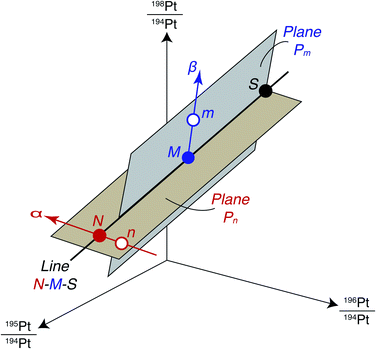 | ||
| Fig. 7 Schematic of the Pt double spike technique in four-isotope space. Adapted from ref. 35. | ||
In four-isotope space (Fig. 7), the points N, n and S lie on the same plane, Pn, while M, m and S lie on a second plane, Pm. These two planes intersect along the mixing line formed by N–M–S. From this mathematical framework, and inputting the parameters n and S as well as the measured value for m, an iterative approach is used to calculate N.
The double spike data reduction assumes that the isotopic difference between the sample (N) and the SRM (n) is solely the result of mass-dependent isotope fractionation. When iron meteorites host resolvable mass-independent (cosmogenic) Pt isotope anomalies (Table 4),1,3 use of the SRM composition as n to determine N will produce biased results for the latter parameter and the associated δ198Pt of the sample. Two measurements are required in this case. One measurement is for a spiked sample aliquot to determine m, whilst a second is needed for the unspiked sample to define the sample isotope composition n, which is then used in the double spike data reduction instead of the SRM composition.17,18 For Pt, this entails using the previously measured internally normalised mass-independent Pt isotope ratios of the samples for n. Notably, the same ratios were previously used to define the cosmogenic Pt isotope anomalies of the samples, which are reported as εiPt values relative to IRMM-010 Pt (Table 4). This approach of using internally normalised data for the unspiked measurements is commonly applied in studies of mass-dependent isotope fractionations of elements that also have mass-independent isotope effects (e.g., Sr, Mo) due to the favourable error propagation and the internal consistency of the results.14,33
To investigate the robustness of the double spike data reduction, mass-independent isotope ratios that were internally normalised to both 198Pt/195Pt and 196Pt/195Pt were applied as the unspiked sample compositions (n). The results reveal that regardless of which internal normalisation scheme is used, the same value of N is always obtained. This reflects that n must lie on a mass-fractionation line with N irrespective of the normalisation scheme that is applied.31 In the example of Tlacotepec shown in Table 5, use of either 198Pt/195Pt or 196Pt/195Pt for internal normalisation of the unspiked sample measurement yields two different n compositions, with 198Pt/194Pt ratios of 0.222690 and 0.222610, respectively. Application of these n compositions in the data reduction then yields identical (within uncertainty) N values of 198Pt/194Pt = 0.222691 and 0.222694, respectively. Issues arise, however, when δ198Pt values are calculated from N. As the result obtained for N is the same, regardless of which normalisation scheme is used for the unspiked measurement, the calculation of δ198Pt values relative to different n values generates different δ198Pt results. For Tlacotepec, calculation of δ198Pt relative to the two n compositions yields significantly different results of 0.00‰ and +0.38‰, respectively (Table 5).
| Unspiked measurement data | 198Pt/194Pt | δ 198Pt (‰) | ||
|---|---|---|---|---|
| n | N | N relative to n | N relative to SRM | |
| Normalised to 198Pt/195Pt | 0.222690 | 0.222691 | +0.00 | −0.21 |
| Normalised to 196Pt/195Pt | 0.222610 | 0.222694 | +0.38 | −0.19 |
| SRM composition | 0.222737 | 0.222665 | −0.32 | −0.32 |
This problem arises because all Pt isotopes that are monitored in the mass-independent isotope analyses (192Pt, 194Pt, 195Pt, 196Pt and 198Pt) are altered by cosmogenic isotope effects. Consequently, Pt lacks an invariant isotope ratio that can be employed to constrain the absolute changes in isotope abundances that were produced by GCR exposure. Rather, use of internal normalisation in the mass-independent isotope measurements of samples fixes a particular Pt isotope ratio to the terrestrial value even if this has a cosmogenic isotope anomaly. The Pt isotope ratios determined from such analyses are therefore ‘skewed’ by mass-independent effects if the normalisation scheme employs an isotope ratio that differs significantly in a sample from the terrestrial value due to GCR exposure. As a consequence, the procedure generates different δ198Pt values for the same sample, depending on which normalisation scheme is used for the unspiked measurement (n).
For consistency and to enable a meaningful comparison of δ198Pt values that are determined for different iron meteorites, δ198Pt is calculated in the following from N (which itself has been calculated using the unspiked composition n) relative to the fixed SRM isotope composition. For Tlacotepec, this leads to essentially identical (within uncertainty) δ198Pt values of −0.21 and −0.19‰ for the two different normalisation schemes that were employed in the mass-independent isotope analyses (Table 5). The procedure of determining δ198Pt from N relative to n, does, however, leave a small mass-independent contribution in the calculated δ198Pt values. This mass-independent contribution to δ198Pt cannot be rigorously quantified since the absolute Pt isotope abundances of unspiked iron meteorites, which have cosmogenic isotope anomalies, are insufficiently constrained by isotope measurements that employ internal normalisation.
It is possible, however, to estimate the magnitude of this remaining mass-independent contribution to δ198Pt for samples that exhibit realistic mass-independent Pt isotope anomalies of less than 10 εiPt (for ε194Pt, ε195Pt, ε196Pt, ε198Pt) and mass-dependent Pt isotope effects of less than 1‰ for δ198Pt. With these constraints, modelling reveals that the remaining mass-independent contributions to δ198Pt are always smaller than ±0.02‰, which is less than the best within-run 2se uncertainties that are reported here for the δ198Pt values of samples (Table 6). As such, the remaining mass-independent contributions to δ198Pt are essentially negligible and this validates the credibility of our approach.
| Group | Sample | N | Pt (μg g−1)b | Ir/Ptc | δ 198Pt(8/5)d (‰) | δ 198Pt(6/5)e (‰) | δ 198Pt(SRM)f (‰) |
|---|---|---|---|---|---|---|---|
| a Number of times sample was analysed. b Pt concentrations determined by isotope dilution. c Ir/Pt ratios calculated using Ir data from Catalogue of Meteorites (2000) and references therein. d δ 198Pt(8/5) values corrected for GCR effects using unspiked data normalised to 198Pt/195Pt. e δ 198Pt(6/5) values corrected for GCR effects using unspiked data normalised to 196Pt/195Pt. f δ 198Pt(SRM) values obtained if no corrections are applied to the data for GCR effects. Uncertainties are 2se = 2σ/√n, where n is the number of times the sample was analysed. | |||||||
| IC | Arispe 3 | 5 | 18.7 | 0.59 | −0.07 ± 0.03 | −0.08 ± 0.03 | −0.09 ± 0.01 |
| Arispe 4 | 5 | 18.9 | 0.59 | −0.02 ± 0.03 | −0.03 ± 0.03 | −0.04 ± 0.02 | |
| Bendego 1 | 5 | 11.80 | 0.02 | 0.31 ± 0.05 | 0.29 ± 0.04 | 0.29 ± 0.03 | |
| Bendego 2 | 5 | 11.5 | 0.02 | 0.30 ± 0.05 | 0.31 ± 0.04 | 0.30 ± 0.04 | |
| Santa Rosa | 5 | 5.1 | 0.01 | 0.19 ± 0.04 | 0.17 ± 0.04 | 0.22 ± 0.04 | |
| IVB | Cape of Good Hope | 6 | 30.1 | 1.05 | −0.01 ± 0.03 | −0.02 ± 0.03 | −0.06 ± 0.02 |
| Santa Clara | 7 | 23.1 | 0.78 | −0.07 ± 0.04 | −0.08 ± 0.04 | −0.09 ± 0.02 | |
| Tlacotepec 1 | 5 | 18.6 | 1.29 | −0.21 ± 0.03 | −0.19 ± 0.04 | −0.32 ± 0.02 | |
If, for comparison, the SRM isotope composition is applied in the double spike data reduction as n to determine N, instead of the data from the unspiked measurement, a δ198Pt value of −0.32‰ is determined for Tlacotepec (Table 5). Our approach therefore corrects the δ198Pt value for a cosmogenic isotope effect of 0.11‰ or 0.13‰, depending on whether the unspiked data for Tlacotepec used 198Pt/195Pt or 196Pt/195Pt for internal normalisation, respectively. Notably, these corrections are in perfect agreement with a previous study, which showed that the δ198Pt value determined for Tlacotepec with the double spike method was shifted by −0.13‰ due to exposure to GCR.10
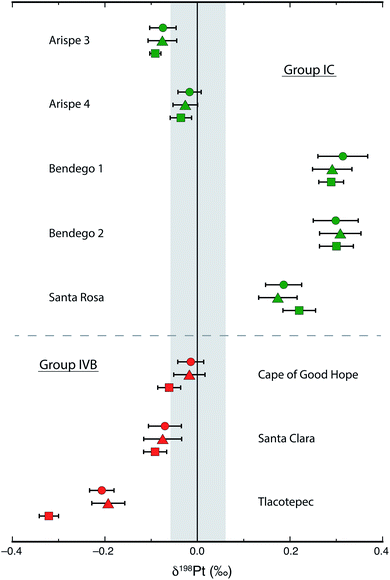 | ||
| Fig. 8 δ 198Pt values of iron meteorites. Circles = δ198Pt(8/5), triangles = δ198Pt(6/5), squares = δ198Pt(SRM). Uncertainties are propagated 2se = 2σ/√n, where n is the number of sample analyses. | ||
With the exception of Tlacotepec, all iron meteorites analysed here have δ198Pt(SRM) results that are identical to the δ198Pt(8/5) and δ198Pt(6/5) values given the analytical uncertainties. In contrast, the δ198Pt(8/5) and δ198Pt(6/5) data for Tlacotepec were corrected for cosmogenic isotope effects of +0.11 and +0.13‰, respectively. The magnitude of the corrections, particularly relative to the spread of δ198Pt values observed for the irons, show that they are significant and will need to be considered in any future high-precision studies of mass-dependent Pt isotope compositions for iron meteorites.
As the cosmogenic isotope effects for 194Pt are dominated by the burnout of 193Ir,3 the Ir/Pt ratio has a critical impact on the GCR-induced isotope anomalies of all Pt isotope ratios that are employed in the double spike data reduction (195Pt/194Pt, 196Pt/194Pt and 198Pt/194Pt) and therefore also on the calculated δ198Pt values. The combined cosmogenic isotope effects for each of these ratios will therefore be a function of both the chemical compositions (Ir/Pt ratio) and the extent of exposure to GCR, and these parameters will vary between samples. For instance, Bendego 2 has δ198Pt values that are identical for the corrected (δ198Pt(8/5), δ198Pt(6/5)) and uncorrected results (δ198Pt(SRM)), even though this sample exhibits cosmogenic isotope effects of a similar magnitude to Tlacotepec in ε196Pt(8/5), with results of 0.96 ± 0.02 and 0.89 ± 0.06, respectively (Tables 4 and 6). However, Bendego 2 displays a much lower cosmogenic isotope anomaly for ε194Pt(8/5) than Tlacotepec, with values of 1.20 ± 0.19 and 2.11 ± 0.11, respectively. The different extents of the cosmogenic isotope anomalies of Bendego 2 and Tlacotepec for ε194Pt(8/5)versus ε196Pt(8/5) is thereby well explained by the much lower Ir/Pt ratio of the former sample (0.02) relative to the latter (1.29; Table 6).
The contribution of cosmogenic isotope effects to the δ198Pt(SRM) values determined with the double spike technique are controlled by several factors, including exposure age, chemical composition, pre-atmospheric meteoroid radius and shielding depth, which will be unique for a specific sample aliquot. In accord with this conclusion, a previous study found that δ198Pt data uncorrected for isotope anomalies induced by GCR exposure were poorly reproducible for some iron meteorites, including for replicate digestions of the same meteorite, and these problems were attributed to variable cosmogenic isotope effects.10 It is therefore paramount that accurate measurements of mass-dependent Pt isotope compositions utilise sample aliquot specific corrections of cosmogenic isotope effects and the methods presented here provide an efficient and effective approach to achieve this.
Intriguingly, our pilot analyses reveal variations in mass-dependent Pt isotope composition both within and between different groups of iron meteorites, whereby the δ198Pt(8/5) values of the IC and IVB irons range from −0.07 to +0.31‰ and −0.21 to −0.01‰, respectively. This suggests that use of our methods to study the mass-dependent Pt isotope compositions of iron meteorites may provide novel constraints on planetary processes, such as core formation and subsequent core cooling and crystallisation.
Conclusions
This study presents new and improved analytical procedures for the determination of both the mass-independent and mass-dependent Pt isotope compositions of iron meteorites. In particular, our method for the separation of Pt is superior to published procedures in terms of sample throughput, Pt yield and the purity of the separated Pt fractions, which enable isotope analyses with no significant interferences from molecular ions or matrix effects. In combination with our MC-ICP-MS measurement routine, this enables the precise acquisition of mass-independent Pt isotope data with internal normalisation of the instrumental mass bias. Such data are of interest to obtain sample aliquot specific constraints on the cosmogenic isotope effects induced by exposure to GCR, as these can be used to correct the correlated anomalies of other affected isotope systems to accurate ‘pre-exposure’ values.Also presented is a new procedure for precise determination of mass-dependent Pt isotope compositions that employs a double spike and MC-ICP-MS. Pilot results obtained for iron meteorites reveal the importance of correcting for cosmogenic Pt isotope effects to obtain unbiased δ198Pt data from the double spike data reduction. It is furthermore shown that the mass-dependent Pt isotope compositions determined for unspiked samples provide sample aliquot specific neutron dosimetry, which can be applied in the data reduction to correct for Pt isotope effects induced by exposure to GCR. This procedure yields accurate mass-dependent Pt isotope compositions for iron meteorites with variable compositions and exposure ages. The initial results of this study reveal significant variations of δ198Pt within and between iron meteorite groups, which suggests that such analyses might yield valuable data for studies of planetary processes.
Author contributions
MR and GP conceived the study. GP and RS undertook the laboratory and mass spectrometry work. GP and MR developed the data reduction methods, the interpretation of the data and wrote the manuscript. RS contributed to the development of the analytical methods.Conflicts of interest
The authors declare no competing interests.Acknowledgements
We thank R. Ickert and a second reviewer for their constructive and thorough reviews, and K. Hall for editorial handling. We are indebted to Barry Coles, Katharina Kreissig and the MAGIC group for help with analytical work. Caroline Smith and Deborah Cassey (The Natural History Museum, London) are recognised for assistance in selecting and providing meteorite specimens. The project was supported by an STFC studentship to GP and a research grant from STFC to MR (ST/J001260/1). GP was supported at Bristol by NERC grant NE/M000419/1.References
- T. S. Kruijer, M. Fischer-Gödde, T. Kleine, P. Sprung, I. Leya and R. Wieler, Earth Planet. Sci. Lett., 2013, 361, 162–172 CrossRef CAS.
- A. C. Hunt, M. Ek and M. Schönbächler, Geochim. Cosmochim. Acta, 2017, 216, 82–95 CrossRef CAS.
- I. Leya and J. Masarik, Meteorit. Planet. Sci., 2013, 48, 665–685 CrossRef CAS.
- R. J. Walker, Earth Planet. Sci. Lett., 2012, 351, 36–44 CrossRef.
- M. Fischer-Gödde and T. Kleine, Nature, 2017, 541, 525–527 CrossRef PubMed.
- T. S. Kruijer, M. Touboul, M. Fischer-Gödde, K. R. Bermingham, R. J. Walker and T. Kleine, Science, 2014, 344, 1150–1154 CrossRef CAS PubMed.
- M. Ek, A. C. Hunt, M. Lugaro and M. Schönbächler, Nat. Astron., 2020, 4, 273–281 CrossRef.
- E. A. Worsham, K. R. Bermingham and R. J. Walker, Earth Planet. Sci. Lett., 2017, 467, 157–166 CrossRef CAS PubMed.
- L. Qin, N. Dauphas, M. F. Horan, I. Leya and R. W. Carlson, Geochim. Cosmochim. Acta, 2015, 153, 91–104 CrossRef CAS.
- J. B. Creech, J. A. Baker, M. R. Handler, J. P. Lorand, M. Storey, A. N. Wainwright, A. Luguet, F. Moynier and M. Bizzarro, Geochemical Perspectives Letters, 2017, 3, 94–104 CrossRef.
- F. Spitzer, C. Burkhardt, G. Budde, T. S. Kruijer, A. Morbidelli and T. Kleine, Astrophys. J., 2020, 898, L2 CrossRef CAS.
- R. M. G. Armytage, R. B. Georg, P. S. Savage, H. M. Williams and A. N. Halliday, Geochim. Cosmochim. Acta, 2011, 75, 3662–3676 CrossRef CAS.
- F. Moynier, Q.-Z. Yin and E. Schauble, Science, 2011, 331, 1417–1420 CrossRef CAS PubMed.
- C. Burkhardt, R. C. Hin, T. Kleine and B. Bourdon, Earth Planet. Sci. Lett., 2014, 391, 201–211 CrossRef CAS.
- K. Murphy, M. Rehkämper, K. Kreissig, B. Coles and T. van de Flierdt, J. Anal. At. Spectrom., 2016, 31, 319–327 RSC.
- G. M. Poole, M. Rehkämper, B. J. Coles, T. Goldberg and C. L. Smith, Earth Planet. Sci. Lett., 2017, 473, 215–226 CrossRef CAS.
- J. F. Rudge, B. C. Reynolds and B. Bourdon, Chem. Geol., 2009, 265, 420–431 CrossRef CAS.
- M. Klaver and C. D. Coath, Geostand. Geoanal. Res., 2019, 43, 5–22 CrossRef CAS.
- M. Rehkämper and A. N. Halliday, Talanta, 1997, 44, 663–672 CrossRef.
- J. B. Creech, J. A. Baker, M. R. Handler and M. Bizzarroc, Chem. Geol., 2014, 363, 293–300 CrossRef CAS PubMed.
- A. C. Hunt, M. Ek and M. Schönbächler, Geostand. Geoanal. Res., 2017, 41, 633–647 CrossRef CAS PubMed.
- T. S. Kruijer, C. Burkhardt, G. Budde and T. Kleine, Proc. Natl. Acad. Sci. U. S. A., 2017, 114, 6712–6716 CrossRef CAS PubMed.
- M. Gault-Ringold and C. H. Stirling, J. Anal. At. Spectrom., 2012, 27, 449–459 RSC.
- M. Berglund and M. E. Wieser, Pure Appl. Chem., 2011, 83, 397–410 CrossRef CAS.
- E. D. Young, A. Galy and H. Nagahara, Geochim. Cosmochim. Acta, 2002, 66, 1095–1104 CrossRef CAS.
- J. Creech, J. Baker, M. Handler, M. Schiller and M. Bizzarro, J. Anal. At. Spectrom., 2013, 28, 853–865 RSC.
- F. Wombacher and M. Rehkämper, J. Anal. At. Spectrom., 2003, 18, 1371–1375 RSC.
- S. Ripperger and M. Rehkämper, Geochim. Cosmochim. Acta, 2007, 71, 631–642 CrossRef CAS.
- C. Siebert, T. F. Nagler and J. D. Kramers, Geochem., Geophys., Geosyst., 2001, 2, 2000GC000124 CrossRef.
- Z. Xue, M. Rehkämper, T. J. Horner, W. Abouchami, R. Middag, T. van de Flierdt and H. J. W. de Baar, Earth Planet. Sci. Lett., 2013, 382, 161–172 CrossRef CAS.
- J. Y. Hu and N. Dauphas, J. Anal. At. Spectrom., 2017, 32, 2024–2033 RSC.
- T. Hopp, M. Fischer-Gödde and T. Kleine, Geochim. Cosmochim. Acta, 2018, 223, 75–89 CrossRef CAS.
- B. L. A. Charlier, I. J. Parkinson, K. W. Burton, M. M. Grady, C. J. N. Wilson and E. G. C. Smith, Geochemical Perspectives Letters, 2017, 4, 35–40 CrossRef.
- E. A. Worsham, C. Burkhardt, G. Budde, M. Fischer-Gödde, T. S. Kruijer and T. Kleine, Earth Planet. Sci. Lett., 2019, 521, 103–112 CrossRef CAS.
- S. J. G. Galer, Chem. Geol., 1999, 157, 255–274 CrossRef CAS.
Footnote |
| † Electronic supplementary information (ESI) available. See DOI: 10.1039/d1ja00468a |
| This journal is © The Royal Society of Chemistry 2022 |

